Special Note: It has occurred to me recently that I'm not the only person who writes about material dealing with oddballBizarre Natural Phenomena. topics. A fellow Steemian who goes by the name @ruth-girl has an ongoing series as well called, I'm promoting her blog as a sign of good faith that I'm not copying her in the slightest. It would appear, that from time to time, we write about similar subjects. I'm simply intrigued as much as she is by this amazing universe we exist in. Please don't hold that against me. :)
Many of the oddball geological features I’ve discussed in prior posts have been beautiful, theoretical and at times mysterious. However, none of them offer the unfortunate event of an untimely death. While the title “Exploding Lakes,” may come off as some sort of ruse to ensnare your curiosity (ahem, clickbait)— it’s in truth a valid description. Technically, I could have entirely exaggerated and gave a title that read, “The Gas Clouds From Hell,” but that would be an inaccurate description given the nature of this series (oddball geological features)… I digress. Today, I’ll be discussing the odd occurence of [limnic eruptions] that are known to occur on explosive lakes. We’ll be going over the regions in which they occur, what causes them and the effects they have on the local environments.
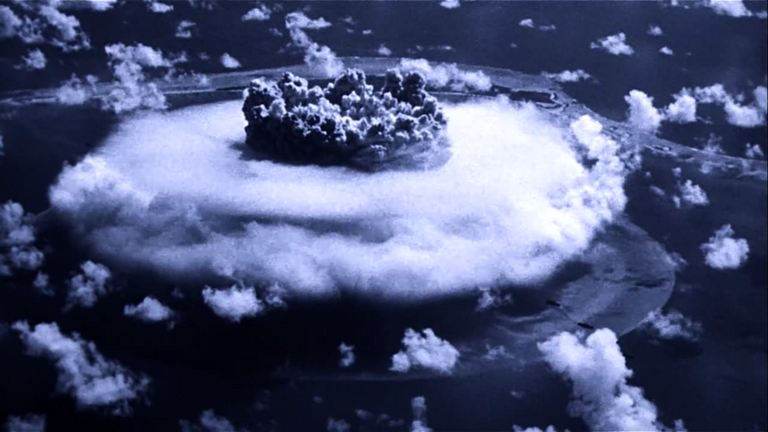 Due to the rarity of limnic eruptions, there aren't any photos of one occurring. This is actually an image of an underwater nuclear test. I can only assume a limnic eruption would look nothing like this, but I needed an eye catching photo. [Image Source]
Due to the rarity of limnic eruptions, there aren't any photos of one occurring. This is actually an image of an underwater nuclear test. I can only assume a limnic eruption would look nothing like this, but I needed an eye catching photo. [Image Source]
What is an explosive lake?
An explosive lake is a fresh body of water in which limnic eruptions (also referred to as lake overturn) occur. A limnic eruption is the natural disaster which occurs in deep lakes that have highly pressurized water below the surface; specifically water that is also saturated with carbon dioxide. From time to time, the water saturated with carbon dioxide becomes unstable, which will then suddenly erupt. These “explosions” have the potential to form a tsunami and a deadly gas cloud capable of localized extinctions. A great analogy for explosive lakes is a shaken can of soda. When the can is opened, the carbon dioxide expands due to the lack of pressure (gas cloud), which causes the liquid to expand as well (tsunami).
Where do explosive lakes occur?

Deadly as they are rare, these lake explosions have only occurred two times in recorded history. Oddly enough, both instances occurred on the African continent in the country of Cameroon. There’s been evidence that these explosions have occurred in the ancient past, such as the fossils found in the Messel Pit located in Germany. Due to the nature of limnic eruption, they leave very little geological evidence behind. As a result, our knowledge of them is fairly limited. However, as I mentioned earlier there have been two instances of explosive lakes that have been well-documented. Both eruptions occurred in Cameroon at Lake Nyos (August, 1986) and Lake Monoun (August, 1994). Technically, Lake Nyos is a circular marr, created from a phreatomagmatic eruption (lava comes into contact with groundwater) 12,000 years ago.
As of right now, scientists are led to believe explosive lakes occur near volcanically active regions. In the case of the lakes I mentioned earlier, they are both located in the Oku Volcanic Field along the Cameroon Volcanic Line of Africa. It should be noted that this doesn’t mean limnic eruptions cannot occur elsewhere, but at the moment it would to appear to be the best explanation based off of recent evidence.
Why do explosive lakes occur?
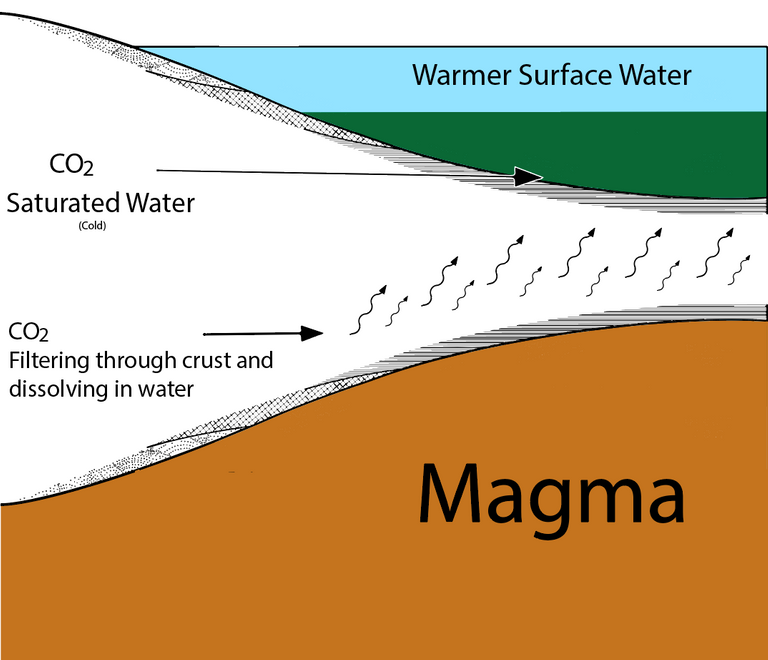 Simplified diagram showing the process that occurs to allow carbon dioxide to form at the bottom of lakes, eventually creating a limnic eruption. In-depth explanation below. Image Source: This diagram was created by the author of this article. @keephy
Simplified diagram showing the process that occurs to allow carbon dioxide to form at the bottom of lakes, eventually creating a limnic eruption. In-depth explanation below. Image Source: This diagram was created by the author of this article. @keephy
Before I dive into the details, it will be useful for you to understand a particular property of magma. While many of you may know magma is in fact molten rock, some of you may not realize that a mass abundance of gases are typically found in it as well (water vapor, carbon dioxide, sulfur dioxide, hydrogen sulfide, etc.). These gases incorporate themselves into their surroundings (e.g. atmosphere, hydrosphere). While this may seem odd at first, when you consider the fact you live on planet that is predominantly water, which also has an atmosphere, this isn’t odd at all. When discussing explosive lakes, we’ll be focusing primarily on the gas carbon dioxide (CO2).
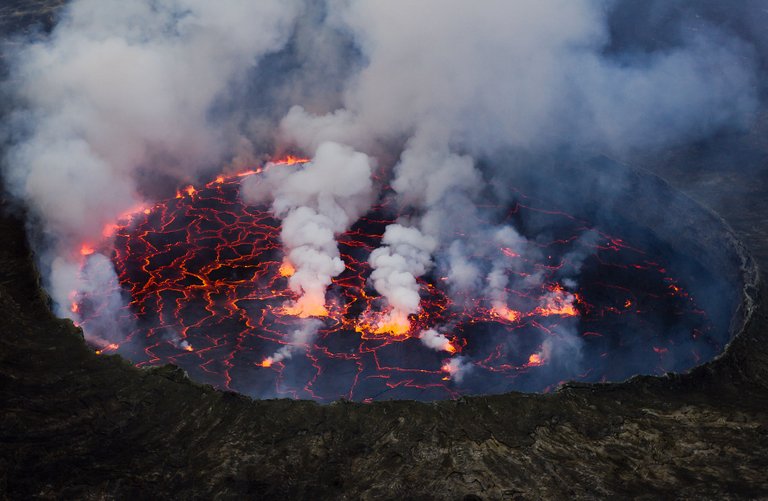 Superheated gases being produced from the lava lake at Mount Nyiragongo. [Image Source]
Superheated gases being produced from the lava lake at Mount Nyiragongo. [Image Source]
In order for limnic explosions to occur the following circumstances must be put in place:
- A volcanically active region
- A deep lake
- An abundance of water saturated with carbon dioxide (CO2) at the bottom of a lake
- Stratified waters of differing temperatures (cold lakebed water, warm surface water)
- A relatively warm and stable climate
- A trigger of some form e.g. earthquake, oversaturation, landslide, heavy rains, etc.
It’s generally assumed that lakes in volcanically active regions reside near or above magma itself. As I mentioned earlier, magma releases massive amounts of carbon dioxide. In the case of the magma residing below a lake, the carbon dioxide filters through layers of crust and slowly dissolves into the water at the bottom of a lake. According to Henry’s Law, in order for the CO2 to dissolve thoroughly, the water must be under an immense amount of pressure; similar to an unopened can of soda. Hence, why deep lakes are more susceptible to limnic explosions. Furthermore, the deeper the lake, the cooler the water is at the bottom, which further helps the process of dissolving CO2.
Most lakes on our planet are holomictic in nature. This means the layers of cooler (bottom) and warmer (surface) water mix year round, which as a result prevents dissolved gases from building up. However, explosive lakes are meromictic in nature. This means the waters of differing temperatures remain stratified, which as a result allows CO2 and other gases to remain dissolved. The current ratio of meromictic to holomictic lakes in the world is 1:1000, making them very rare.
What appears to be the most important factor in order for limnic explosions to occur, is where the lake itself resides. Typically, most lakes of the world have convecting water occuring in them. This is due to seasonal weather patterns that change the surface temperature of the water, which as a result changes the water density allowing convection to occur. In the instance of Lake Nyos or Lake Manoun in Africa, both of these lakes reside in tropical climates that have very warm spring and fall weather. As a result, the water residing in those lakes fail to convect the water efficiently enough to release the built up CO2 at the bottom of the lake. In effect, tens of millions of cubic meters of CO2 can accumulate. Again, the water saturated with CO2 is under immense pressure. It’s essentially the world’s biggest can of soda in existence.
So how does all of that CO2 erupt to the surface?
Initially, scientists didn’t understand how the limnic eruptions on Lake Ryos and Manoun occurred. Even till this day, they’ve only been able to draw conclusions. However, due to the fragility of the pressurized CO2, they concluded a number of different events could occur that could trigger a limnic eruptions. They are as follows:
- Regional seismic activity (small earthquake)
- Landslides that occur within the lake
- Heavy rains could lower the surface temperature causing the water to sink and as a consequence, the saturated CO2 water is disturbed.
All of these are valid explanations, but it’s very difficult for scientists to ascertain the direct trigger due to the volatility of the eruptions. Regardless, when the pressurized water becomes disturbed by such an event, it allows for it to move up to surface. As the pressure decreases, the dissolved CO2 begins to expand. As a consequence, the water is displaced by the build up bubbles (think soda in a can), which causes it to swell and in essence, creates a legitimate tsunami. By far and away, the most catastrophic aspect of limnic explosions is the massive cloud of CO2 that occurs afterwards. Due to pure CO2 being denser than our atmospheric air, the gas will push the air near the planets surface out of the way. As a result, anything in its path will be suffocated, except for plants of course (they feed on CO2).
Historical and potential instances of limnic explosions:
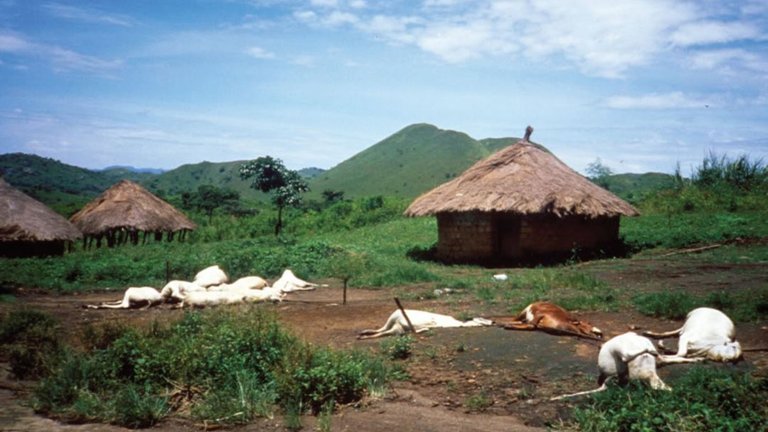 This image displays the aftermath of the limnic eruption of Lake Nyos in Cameroon. [Image Source: USGS/Public Domain]
This image displays the aftermath of the limnic eruption of Lake Nyos in Cameroon. [Image Source: USGS/Public Domain]
What I described above is exactly what occurred on August 21st, 1986 at Lake Nyos in Cameroon. The explosion happened in the dead of night, leaving unsuspecting villagers in nearby valleys completely unaware of the threat headed their way. The massive cloud of carbon dioxide traveled downhill, killing roughly 1,700 people and 3,500 livestock. It is suspected that a landslide within the lake caused the eruption to be triggered. Similarly, in 1984 a limnic explosion killed 37 people near Lake Monoun in Cameroon. These are the only two known limnic explosions to have been documented. Though I suspect there are other lakes capable of such a geological event. In order to prevent future explosions, pipes have been installed throughout the lake which siphon the gas from the bottom, steadily releasing it.
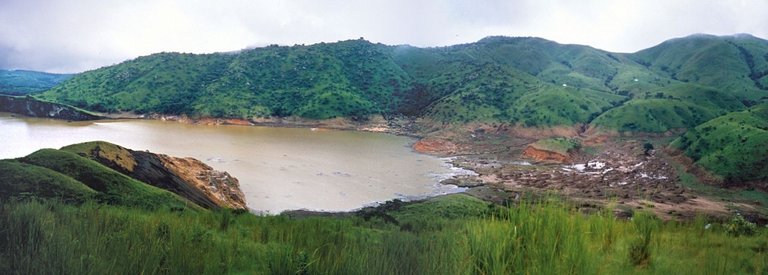 This image displays the damage from the tsunami along the Lake Nyos shoreline caused by the limnic eruption. [Image Source]
This image displays the damage from the tsunami along the Lake Nyos shoreline caused by the limnic eruption. [Image Source]
Through the data collected by these tragedies, scientists have been able better understand where they might strike next. Another lake in Africa capable of causing limnic explosions is Lake Kivu, which borders Rwanda and the Democratic Republic of Congo. Roughly 2 million people live on the shorelines of Lake Kivu so the threat of an explosion is taken very serious. A similar process is occurring on Kivu as the lakes mentioned earlier. However, this time there are two gases involved, which are CO2 and methane (CH4). So instead of just a death cloud from hell, there is the potential for an actual fiery explosion as well.
When scientists began to study the soils resting on the bottom of Lake Kivu, they found evidence of lakewide extinctions that occur every few thousand years. They believe limnic explosions are the cause of these extinctions. Furthermore, the existence of methane is caused by bacteria in the lake that feed on the CO2, creating the gas as a result. There’s such an abundance of methane lying at the bottom of Lake Kivu that scientists have gotten very creative when trying to eliminate the risks of future limnic explosions.
This image display a methane extraction platform located on Lake Kivu. [Image Source]

By far, the most creative solution is to actually harness the methane to use as a form of energy. Studies have shown there’s enough methane to power the countries of Rwanda, DRC and possibly one more! As of right now, there is only one extract platform that collects methane for this purpose, but it’s more of a flagship plant than anything else. The hope is that it will gain interest from the international community and bring potential investors to the table. Unfortunately, it would appear the threat of a limnic explosions occurring is still a possibility due the lack of measures taken to limit them on Kivu. This is in large part due to the fact Lake Kivu is much larger than lakes I mentioned earlier, meaning a larger plan must be put in place, which requires more money.
Conclusion:
While it would appear explosive lakes are limited to specific regions of the world, I believe it’s important that any lake near volcanically active regions— that have dense populations living on or near their shores— should be investigated. As I’ve mentioned in prior posts, it’s unfortunate that much of our knowledge regarding the geological processes on Earth, typically derive after the event has taken place. Obviously the result of such an event, means people are often affected by them. There is a plethora of examples of dense populations living in harm’s way, geologically speaking. Hopefully, as time progresses and we grow as a society, we’ll learn to steer clear of such regions; rather than trying to defeat them. It’s become abundantly clear that mother nature will more often than not, win that battle.
Other Oddball Geological Features:
Vol. 1 – Chocolate Hills of Bohol
Vol. 2 – The Sailing Stones of the Playa
Vol. 3 – Rainbow Mountains of China
Vol. 4 – Olymus Mons On Mars
Vol. 5 – The Cryovolcanoes of Enceladus
Vol. 6 – Gargantuan Crystals
Bibliography:
https://en.wikipedia.org/wiki/Limnic_eruption
https://en.wikipedia.org/wiki/Lake_Nyos_disaster
https://en.wikipedia.org/wiki/Lake_Monoun
https://en.wikipedia.org/wiki/Lake_Kivu
https://en.wikipedia.org/wiki/Messel_pit
https://en.wikipedia.org/wiki/Henry%27s_law
https://en.wikipedia.org/wiki/Lake_Nyos_disaster
https://en.wikipedia.org/wiki/Oku_Volcanic_Field
http://volcano.oregonstate.edu/vwdocs/volc_images/africa/nyos.html
https://www.voanews.com/a/survivors-1986-lake-nyos-disaster-cameroon/3474673.html
https://pubs.er.usgs.gov/publication/70032981
https://www2.usgs.gov/blogs/features/usgs_top_story/exploding-lakes-in-west-africa/
If you enjoyed reading this post, be sure to give me a follow and check out the rest of my blog. Overall, my blog consists of scientific topics dealing with geology, meteorology, geography, food and history. It's also peppered with a bit of photography and journal entries. The goal of this blog isn’t to earn money per se. While that is a nice benefit, I’m more interested in networking, learning, informing and helping the Steemit community grow to new heights. Also, be sure to use the steemstem tag and join @Geopolis if you're a fellow geologist! Thanks for all your support!


You received a 80.0% upvote since you are a member of geopolis and wrote in the category of "geology".
To read more about us and what we do, click here.
https://steemit.com/geopolis/@geopolis/geopolis-the-community-for-global-sciences-update-4
Being A SteemStem Member
Nice blog with vast amount of informative content within it!Looking for more posts!!
Thank you for the shout-out! It's just like you said it, we are intrigued by nature's creativity.
Limnic eruptions are dangerous, thank God thy don't happen so often. I liked how you covered the topic @keephy! :)
Incredible! Never heard about this geologic feature. Any examples of this in the United States that people can visit?
At the moment, the only known exploding lakes are in Africa. It would appear they only develop under very special circumstances. However, I would bet my bottom dollar more exist in the world. I also saw examples of possible limnic eruptions on other deep likes such as Crater Lake in Oregon. Truth be told, our knowledge of this planet is fairly limited. That's not to say we don't know anything, but it would appear the geological processes occurring here have more in store for us in the future.